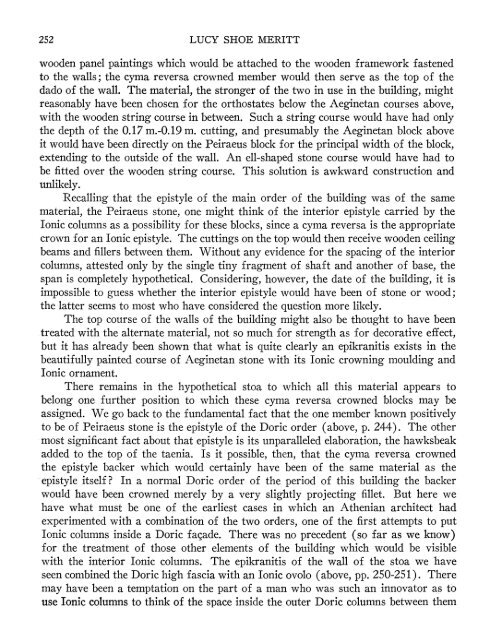the stoa poikile - The American School of Classical Studies at Athens
the stoa poikile - The American School of Classical Studies at Athens
the stoa poikile - The American School of Classical Studies at Athens
Create successful ePaper yourself
Turn your PDF publications into a flip-book with our unique Google optimized e-Paper software.
252 LUCY SHOE MERITT<br />
wooden panel paintings which would be <strong>at</strong>tached to <strong>the</strong> wooden framework fastened<br />
to <strong>the</strong> walls; <strong>the</strong> cyma reversa crowned member would <strong>the</strong>n serve as <strong>the</strong> top <strong>of</strong> <strong>the</strong><br />
dado <strong>of</strong> <strong>the</strong> wall. <strong>The</strong> m<strong>at</strong>erial, <strong>the</strong> stronger <strong>of</strong> <strong>the</strong> two in use in <strong>the</strong> building, might<br />
reasonably have been chosen for <strong>the</strong> orthost<strong>at</strong>es below <strong>the</strong> Aeginetan courses above,<br />
with <strong>the</strong> wooden string course in between. Such a string course would have had only<br />
<strong>the</strong> depth <strong>of</strong> <strong>the</strong> 0.17 m.-O.19 m. cutting, and presumably <strong>the</strong> Aeginetan block above<br />
it would have been directly on <strong>the</strong> Peiraeus block for <strong>the</strong> principal width <strong>of</strong> <strong>the</strong> block,<br />
extending to <strong>the</strong> outside <strong>of</strong> <strong>the</strong> wall. An ell-shaped stone course would have had to<br />
be fitted over <strong>the</strong> wooden string course. This solution is awkward construction and<br />
unlikely.<br />
Recalling th<strong>at</strong> <strong>the</strong> epistyle <strong>of</strong> <strong>the</strong> main order <strong>of</strong> <strong>the</strong> building was <strong>of</strong> <strong>the</strong> same<br />
m<strong>at</strong>erial, <strong>the</strong> Peiraeus stone, one might think <strong>of</strong> <strong>the</strong> interior epistyle carried by <strong>the</strong><br />
Ionic columns as a possibility for <strong>the</strong>se blocks, since a cyma reversa is <strong>the</strong> appropri<strong>at</strong>e<br />
crown for an Ionic epistyle. <strong>The</strong> cuttings on <strong>the</strong> top would <strong>the</strong>n receive wooden ceiling<br />
beams and fillers between <strong>the</strong>m. Without any evidence for <strong>the</strong> spacing <strong>of</strong> <strong>the</strong> interior<br />
columns, <strong>at</strong>tested only by <strong>the</strong> single tiny fragment <strong>of</strong> shaft and ano<strong>the</strong>r <strong>of</strong> base, <strong>the</strong><br />
span is completely hypo<strong>the</strong>tical. Considering, however, <strong>the</strong> d<strong>at</strong>e <strong>of</strong> <strong>the</strong> building, it is<br />
impossible to guess whe<strong>the</strong>r <strong>the</strong> interior epistyle would have been <strong>of</strong> stone or wood;<br />
<strong>the</strong> l<strong>at</strong>ter seems to most who have considered <strong>the</strong> question more likely.<br />
<strong>The</strong> top course <strong>of</strong> <strong>the</strong> walls <strong>of</strong> <strong>the</strong> building might also be thought to have been<br />
tre<strong>at</strong>ed with <strong>the</strong> altern<strong>at</strong>e m<strong>at</strong>erial, not so much for strength as for decor<strong>at</strong>ive effect,<br />
but it has already been shown th<strong>at</strong> wh<strong>at</strong> is quite clearly an epikranitis exists in <strong>the</strong><br />
beautifully painted course <strong>of</strong> Aeginetan stone with its Ionic crowning moulding and<br />
Ionic ornament.<br />
<strong>The</strong>re remains in <strong>the</strong> hypo<strong>the</strong>tical <strong>stoa</strong> to which all this m<strong>at</strong>erial appears to<br />
belong one fur<strong>the</strong>r position to which <strong>the</strong>se cyma reversa crowned blocks may be<br />
assigned. We go back to <strong>the</strong> fundamental fact th<strong>at</strong> <strong>the</strong> one member known positively<br />
to be <strong>of</strong> Peiraeus stone is <strong>the</strong> epistyle <strong>of</strong> <strong>the</strong> Doric order (above, p. 244). <strong>The</strong> o<strong>the</strong>r<br />
most significant fact about th<strong>at</strong> epistyle is its unparalleled elabor<strong>at</strong>ion, <strong>the</strong> hawksbeak<br />
added to <strong>the</strong> top <strong>of</strong> <strong>the</strong> taenia. Is it possible, <strong>the</strong>n, th<strong>at</strong> <strong>the</strong> cyma reversa crowned<br />
<strong>the</strong> epistyle backer which would certainly have been <strong>of</strong> <strong>the</strong> same m<strong>at</strong>erial as <strong>the</strong><br />
epistyle itself ? In a normal Doric order <strong>of</strong> <strong>the</strong> period <strong>of</strong> this building <strong>the</strong> backer<br />
would have been crowned merely by a very slightly projecting fillet. But here we<br />
have wh<strong>at</strong> must be one <strong>of</strong> <strong>the</strong> earliest cases in which an A<strong>the</strong>nian architect had<br />
experimented with a combin<strong>at</strong>ion <strong>of</strong> <strong>the</strong> two orders, one <strong>of</strong> <strong>the</strong> first <strong>at</strong>tempts to put<br />
Ionic columns inside a Doric facade. <strong>The</strong>re was no precedent (so far as we know)<br />
for <strong>the</strong> tre<strong>at</strong>ment <strong>of</strong> those o<strong>the</strong>r elements <strong>of</strong> <strong>the</strong> building which would be visible<br />
with <strong>the</strong> interior Ionic columns. <strong>The</strong> epikranitis <strong>of</strong> <strong>the</strong> wall <strong>of</strong> <strong>the</strong> <strong>stoa</strong> we have<br />
seen combined <strong>the</strong> Doric high fascia with an Ionic ovolo (above, pp. 250-251). <strong>The</strong>re<br />
may have been a tempt<strong>at</strong>ion on <strong>the</strong> part <strong>of</strong> a man who was such an innov<strong>at</strong>or as to<br />
use Ionic columns to think <strong>of</strong> <strong>the</strong> space inside <strong>the</strong> outer Doric columns between <strong>the</strong>m

















